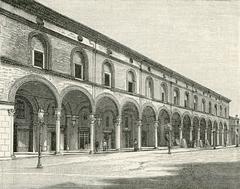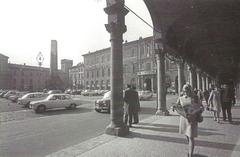Monumento Ai Caduti Della Prima Guerra Mondiale, Imola: Visiting Hours, Tickets, and Complete Guide
Date: 14/06/2025
Introduction
The Monumento Ai Caduti Della Prima Guerra Mondiale in Imola, Italy, is a significant site of remembrance dedicated to the soldiers who lost their lives during World War I. Erected in the aftermath of a devastating conflict, the monument stands not only as a symbol of local and national mourning but also as a testament to the enduring values of peace, unity, and civic identity. This guide provides a comprehensive overview of the monument’s history, artistic features, visiting information, accessibility, commemorative events, and practical tips to enrich your visit.
Contents
- Historical Origins and Purpose
- Artistic and Symbolic Features
- Political and Social Context
- Visiting Hours, Tickets, and Accessibility
- Guided Tours and Special Events
- Community Memory and Educational Role
- The Monument in Broader Italian Context
- Postwar Evolution and Current Significance
- Frequently Asked Questions (FAQ)
- Travel Tips and Nearby Attractions
- Summary and Visitor Tips
- Sources and Further Reading
Historical Origins and Purpose
The Monumento Ai Caduti Della Prima Guerra Mondiale was commissioned in the 1920s, during a period when Italy grappled with the immense loss and trauma of World War I. Like many towns across the nation, Imola sought to commemorate its fallen through the creation of a permanent public memorial. Inaugurated in 1928, the monument originally stood in Piazza Vittorio Emanuele, symbolizing a bridge between the living and the dead and serving as a focal point for collective remembrance (Pietre di Memoria).
Over the years, the monument’s location has changed, reflecting both evolving attitudes toward public memory and the city’s desire for a more contemplative setting. Today, it resides in Giardino Stefanino Curti, integrated into Imola’s “Percorso della Memoria” (Path of Memory), underscoring its centrality in the city’s commemorative landscape (Pietre della Memoria).
Artistic and Symbolic Features
Design Elements
The monument features a striking bronze allegorical statue of Victory, crafted with expressive realism to embody resilience and triumph. This central figure is set against a masonry wall with pilasters and blind arches, complemented by a frescoed exedra depicting wartime scenes. At the apex, a high-relief of Italia Turrita symbolizes national unity (Catalogo Beni Culturali).
Commemorative Inscriptions
Stone plaques bear the names of Imola’s fallen soldiers, flanked by civic heraldry and sculptural elements such as masks and water basins, which represent purification and the continuity of life. Benches and tree-lined avenues further enhance the solemn and reflective ambiance.
Political and Social Context
Constructed during the interwar period, the monument’s history is intertwined with the rise of Fascism in Italy. The regime used such monuments to promote a “cult of the fallen hero,” appropriating their symbolism for political ends (Wikipedia: World War I memorials). However, at the local level, communities like Imola maintained their own rituals and connections to these sites, ensuring the memorial’s enduring significance beyond political shifts.
Visiting Hours, Tickets, and Accessibility
Location
- Address: Giardino Stefanino Curti, Imola, Italy
Hours & Admission
- Open daily: 7:00 AM – 9:00 PM
- Admission: Free; no tickets required
Accessibility
- The monument and garden are fully wheelchair accessible, with paved paths and benches.
- Suitable for all ages and mobility levels.
Guided Tours and Special Events
- Guided tours are occasionally organized by the Imola tourism office and during commemorative ceremonies.
- Major annual events include November 4th (National Unity and Armed Forces Day) and April 25th (Liberation Day), featuring public ceremonies, wreath-laying, and participation by local officials, veterans, and students (Comune di Imola, ANPI Imola).
Community Memory and Educational Role
The monument holds a vital place in Imola’s collective memory. Funded by voluntary donations from families of the fallen, it remains a focal point for civic ceremonies and school visits. The relocation debate in the early 2000s highlighted the community’s attachment to the memorial and the ongoing dialogue about the role of commemorative spaces (novecento.org). Educational initiatives frequently bring students to the site, fostering intergenerational reflection on history and citizenship.
The Monument in Broader Italian Context
Imola’s war memorial is part of a network of over 12,000 such monuments across Italy. These sites collectively embody the nation’s response to the unprecedented losses of World War I and represent a major shift in commemorative culture, embedding the memory of sacrifice within everyday urban and rural landscapes (Wikipedia: World War I memorials, catalogo.beniculturali.it).
Postwar Evolution and Current Significance
Following World War II and the collapse of Fascism, the monument’s political overtones receded, but its role in community remembrance endured. Restoration efforts, educational programs, and renewed public interest since the 1980s have preserved its relevance. Today, the monument remains a living site of memory, central to Imola’s civic identity and historical consciousness (ANPI Imola).
Frequently Asked Questions (FAQ)
Q: What are the visiting hours?
A: Giardino Stefanino Curti is open daily from 7:00 AM to 9:00 PM.
Q: Is there an entrance fee or tickets required?
A: No, the monument is free to visit.
Q: Are guided tours available?
A: Guided tours are occasionally offered through the Imola tourism office or during commemorative events.
Q: Is the site accessible for visitors with disabilities?
A: Yes, the monument and surrounding paths are wheelchair accessible.
Q: Can I take photographs?
A: Yes, photography is allowed for personal use. For professional shoots, contact local authorities.
Q: When are commemorative events held?
A: The main ceremonies take place on November 4th and April 25th.
Travel Tips and Nearby Attractions
- Nearby Sites: Rocca Sforzesca fortress, Basilica di San Cassiano, Autodromo Enzo e Dino Ferrari, and Santa Maria del Piratello.
- How to Get There: Centrally located, accessible on foot, by bicycle, or public transport; parking is available nearby.
- Best Times to Visit: Spring and autumn for mild weather; commemorative days for unique local traditions.
- Etiquette: Maintain a respectful demeanor; avoid loud conversations and disruptive behavior.
- Facilities: Benches and public restrooms are available in the garden. Cafés and shops are nearby.
Summary and Visitor Tips
The Monumento Ai Caduti Della Prima Guerra Mondiale in Imola is a cornerstone of the city’s historical and cultural identity. Free and accessible year-round, it provides a meaningful destination for reflection, learning, and participation in Italy’s vibrant commemorative traditions. Combine your visit with Imola’s other heritage sites for a deeper appreciation of the city’s history and spirit (Wanderlog).
Sources and Further Reading
- Pietre di Memoria
- Pietre della Memoria
- Catalogo Beni Culturali
- Wikipedia: World War I memorials
- Comune di Imola
- ANPI Imola
- Wanderlog
- novecento.org
- catalogo.beniculturali.it
- areablu.com
- laltraimola.it
- Mapcarta
Plan your visit to the Monumento Ai Caduti Della Prima Guerra Mondiale in Imola and connect with a vital chapter of Italian and European history. For updates on tours, events, and travel tips, follow local tourism resources or download the Audiala app. By honoring the past, you play a part in sustaining the legacy of remembrance for future generations.


